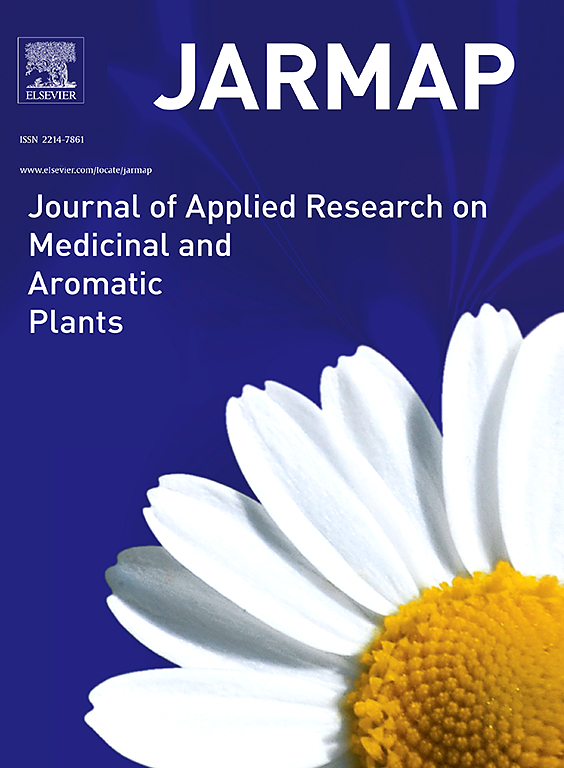Supercritical fluid extraction of Bidens pilosa L. oil: Kinetics evaluation and antitumor activity
IF 3.6
2区 农林科学
Q1 PLANT SCIENCES
Journal of Applied Research on Medicinal and Aromatic Plants
Pub Date : 2025-05-01
DOI:10.1016/j.jarmap.2025.100641
引用次数: 0
Abstract
Different plants have been used, around the world, in the treatment of primary diseases as an alternative or popular medicine. In Brazil, the Health Minister introduced a national politic for the phytotherapy use in the Single Health System (SUS). Due to that, Bidenspilosa L. (Asteraceae) was chosen because it is one of the medicinal plants present in the Single Health System list, called RENISUS. Bidens pilosa L. is a popular plant used in the treatment of different diseases (malaria, cancer tumors, fever, diabetes, infections, inflammations, angina, etc.) and is widely disseminated throughout the tropical and subtropical regions of the world. The biological activities of the plant are attributed to the presence of flavonoids, polyacetylenes and terpenes. Therefore, this study evaluated the biological activities of the oil extraction using supercritical CO2 at different pressure and temperature conditions, due to the scarcity of studies comparing supercritical fluid extraction to conventional techniques (Soxhlet and maceration). The experimental procedure used 8 g of previously dried and milled leaves at different conditions according to an experimental design (150 bar - 60 °C; 179 bar - 46 °C; 179 bar - 74 °C; 250 bar - 40 °C; 250 bar - 80 °C; 321 bar - 46 °C; 321 bar - 74 °C, 350 bar - 60 °C, 250 bar - 60 °C). According to the results, the best yield was 0.082 % (6.6 mg) at 321 bar and 74 °C. The analyses of the experiments done at 321 bar at 74 °C and 250 bar at 40 °C, showed ultraviolet spectra characteristic of terpenes. The extracts analyzed showed promising inhibition in the two tumor cell lines: melanoma, SK-MEL-28 (68 %) and leukemia K562 (90 %), both at a concentration of 150 μg/mL. The results suggested the importance of the bioactive components from Bidens pilosa to contribute to a new anticancer drug using supercritical technology.
槐油超临界萃取:动力学评价及抗肿瘤活性
在世界各地,不同的植物已被用作治疗原发性疾病的替代药物或流行药物。在巴西,卫生部长提出了在单一卫生系统(SUS)中使用植物疗法的国家政策。因此,选择Bidenspilosa L. (Asteraceae)是因为它是单一卫生系统清单(称为RENISUS)中存在的药用植物之一。Bidens pilosa L.是一种流行的植物,用于治疗不同的疾病(疟疾、癌症肿瘤、发烧、糖尿病、感染、炎症、心绞痛等),广泛分布在世界的热带和亚热带地区。该植物的生物活性归因于黄酮类化合物、聚乙炔和萜烯的存在。因此,由于缺乏将超临界流体萃取与常规技术(索氏和浸渍)进行比较的研究,因此,本研究评估了超临界CO2在不同压力和温度条件下的生物活性。实验程序使用8 g先前干燥和研磨的叶子,根据实验设计(150 bar - 60°C;179 bar - 46°C;179 bar - 74°C;250 bar - 40℃;250 bar - 80℃;321 bar - 46°C;321 bar - 74°C, 350 bar - 60°C, 250 bar - 60°C)。结果表明,在321 bar、74℃条件下,最佳产率为0.082 %(6.6 mg)。在74°C下321 bar和40°C下250 bar进行的实验分析显示了萜烯的紫外光谱特征。所分析的提取物对两种肿瘤细胞系SK-MEL-28(68 %)和白血病K562(90 %)均有抑制作用,浓度均为150 μg/mL。研究结果表明,从毛缕草中提取的活性成分对利用超临界技术开发新型抗癌药物具有重要意义。
本文章由计算机程序翻译,如有差异,请以英文原文为准。
求助全文
约1分钟内获得全文
求助全文
来源期刊

Journal of Applied Research on Medicinal and Aromatic Plants
Pharmacology, Toxicology and Pharmaceutics-Drug Discovery
CiteScore
6.40
自引率
7.70%
发文量
80
审稿时长
41 days
期刊介绍:
JARMAP is a peer reviewed and multidisciplinary communication platform, covering all aspects of the raw material supply chain of medicinal and aromatic plants. JARMAP aims to improve production of tailor made commodities by addressing the various requirements of manufacturers of herbal medicines, herbal teas, seasoning herbs, food and feed supplements and cosmetics. JARMAP covers research on genetic resources, breeding, wild-collection, domestication, propagation, cultivation, phytopathology and plant protection, mechanization, conservation, processing, quality assurance, analytics and economics. JARMAP publishes reviews, original research articles and short communications related to research.
 求助内容:
求助内容: 应助结果提醒方式:
应助结果提醒方式:


